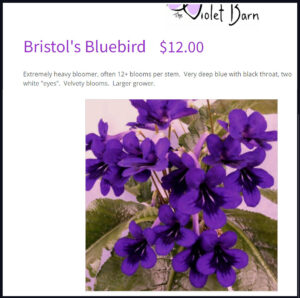Violet Barn Streptocarpus plants: Many will have semidouble or double blooms, which means flowers last longer and don’t fall from stems when faded. A few are even fragrant!
These gesneriads will bloom heavily year-round. Very easy to grow and bloom, and are great for windows.
Trumpet-shaped blooms with flat faces are borne over strap-like leaves. Unlike violets, each leaf will produce 8-10 or more bloom stalks, sequentially, so that plants tend to stay in heavy bloom for long periods of time.
Culture and care is the same as for violets. Extremely easy to grow.
Most varieties grow best in 5″ when mature, perhaps a 6″ pot if very large. The exact size of the plant can be controlled by the grower–if leaves become too long just trim with scissors!
Pot into 3″ pot at first bloom.
STREPTOCARPUS: REPOTTING AND DIVIDING
This lesson will demonstrate when and how to pot Streptocarpus plants into larger pots, and how to divide and repot a mature plant. More so than some other gesneriads, streps like to have fresh, light, soil into which they can produce new root growth–they need “happy feet”. Some streps in our collection have been in continuous bloom for 5 years or more
 Step 1: Potting-up into a 3″ pot. When the first bloom appears on a young plantlet in its original 2″ pot, it is ready to be potted-up into a larger, 3″ pot. It’s best if both the new soil (in the 3″ pot) and the plantlet’s soil are moist (not dry, not soggy). Make a “mold” in the 3″ pot by making a hole in the center about the size of the plantlet’s pot. Having done this, the plantlet can then be easily dropped into the molded hole.
Step 1: Potting-up into a 3″ pot. When the first bloom appears on a young plantlet in its original 2″ pot, it is ready to be potted-up into a larger, 3″ pot. It’s best if both the new soil (in the 3″ pot) and the plantlet’s soil are moist (not dry, not soggy). Make a “mold” in the 3″ pot by making a hole in the center about the size of the plantlet’s pot. Having done this, the plantlet can then be easily dropped into the molded hole.
 Step 2: The just potted plant. Firm the plantlet in, and be sure to label the pot. For the next 2-3 weeks after any repotting, water more sparingly! The recently repotted plant needs time to establish new root growth into the additional soil. (See photo right)
Step 2: The just potted plant. Firm the plantlet in, and be sure to label the pot. For the next 2-3 weeks after any repotting, water more sparingly! The recently repotted plant needs time to establish new root growth into the additional soil. (See photo right)
 Strep 3: Potting-up into a 4″ or 5″ pot. Once in a 3″ pot, most streps will grow very quickly! For compact growers this means a 4″, and for most other varieties, a 5″ pot. Shallow “azalea” pots are best. Basically you just repeat step #1. (see photo at left)
Strep 3: Potting-up into a 4″ or 5″ pot. Once in a 3″ pot, most streps will grow very quickly! For compact growers this means a 4″, and for most other varieties, a 5″ pot. Shallow “azalea” pots are best. Basically you just repeat step #1. (see photo at left)
 Step 4: Dividing streps by separating crowns. After about 6 months in its final, larger, pot, your strep will need to be repotted again into fresh soil. By then, the plant may be thick with foliage and you may notice more than one plant, or “crown”, growing in the pot. First, cut away some of the older growth. These leaves have likely already produced a number of bloom stalks and have served their purpose (we’ve already done this with the plant pictured at left). Next, you’ll want to divide and separate the multiple plants that appear in the pot. Begin to do this by making a shallow cut through the surface growth that usually joins the multiple crowns. Sometimes this growth is quite tough. You needn’t cut through the entire rootball, just the tough growth at the surface.
Step 4: Dividing streps by separating crowns. After about 6 months in its final, larger, pot, your strep will need to be repotted again into fresh soil. By then, the plant may be thick with foliage and you may notice more than one plant, or “crown”, growing in the pot. First, cut away some of the older growth. These leaves have likely already produced a number of bloom stalks and have served their purpose (we’ve already done this with the plant pictured at left). Next, you’ll want to divide and separate the multiple plants that appear in the pot. Begin to do this by making a shallow cut through the surface growth that usually joins the multiple crowns. Sometimes this growth is quite tough. You needn’t cut through the entire rootball, just the tough growth at the surface.
 Step 5: Separate into two or more plants. Once you’ve made the initial cut described above, firmly grasp the two plants and carefully pull apart. You should be able to separate the original potted plant into two or more smaller plants, each with its own root ball. At this point, these separate plants can each be potted into their own pots (repeat step 3). Again, be careful in your watering immediately after potting.
Step 5: Separate into two or more plants. Once you’ve made the initial cut described above, firmly grasp the two plants and carefully pull apart. You should be able to separate the original potted plant into two or more smaller plants, each with its own root ball. At this point, these separate plants can each be potted into their own pots (repeat step 3). Again, be careful in your watering immediately after potting.
In another 6 months or so, this will need to be repeated again. Streps will go much longer without repotting, but will be healthiest, and perform and bloom best when repotting is done in a regular, timely, manner. Gesneriads are “survivors”–they will do their best to live under even the worst of conditions, and streps are better at this than most. But for them to look and perform their best, they need to be cared for when they require it, not when its “convenient” for us (though admittedly, we all procrastinate a bit….).



